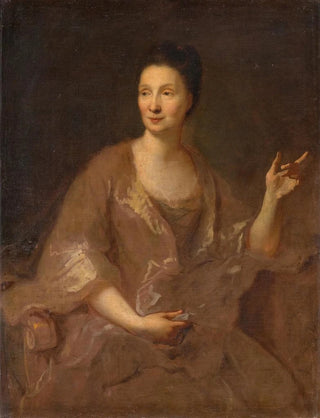Art print | Portrait of a woman - Jean-François de Troy Source: Reproduction | Portrait d'une femme - Jean-François de Troy


View from behind

Frame (optional)
Portrait of a woman - Jean-François de Troy – Captivating introduction
In the fascinating world of 18th-century French painting, the "Portrait of a woman" by Jean-François de Troy stands out for its delicacy and emotional depth. This artwork, which captures the very essence of femininity, transports us to a time when art reflected the morals and aspirations of society. The depiction of this woman, both mysterious and charismatic, invites viewers to ponder her identity and story. The soft light caressing her face and the meticulous details of her attire testify to unparalleled craftsmanship, making this portrait a masterpiece of portrait art.
Style and uniqueness of the work
Jean-François de Troy's style is rooted in the rococo tradition, characterized by lightness and elegance that transcend time. In "Portrait of a woman," the artist skillfully plays with light and shadow, creating an intimate atmosphere that highlights the beauty and grace of his model. The pastel colors, gentle and harmonious, evoke a certain melancholy while maintaining a vibrancy that draws the eye. The composition is carefully orchestrated, with each element thoughtfully chosen to enhance the expression of the woman's personality. This portrait is not merely a simple representation; it is an invitation to discover the soul of its subject, to feel the emotions that inhabit her. Thus, Jean-François de Troy manages to transcend mere pictorial technique to offer a work of rare psychological depth.
The artist and his influence
Jean-François de Troy, born in 1679, is an emblematic artist of his time, whose work significantly contributed to shaping the French artistic landscape. A pupil of great masters such as Nicolas de Largillière, he developed a style that is uniquely his own, blending classical influences with innovations characteristic of the rococo movement. De Troy is also recognized for his ability to capture daily life and portraits of his contemporaries with a unique sensitivity. His influence extends beyond his own production, inspiring many artists who followed. By incorporating elements of social life and psychological subtleties into his works, he

Matte finish

View from behind

Frame (optional)
Portrait of a woman - Jean-François de Troy – Captivating introduction
In the fascinating world of 18th-century French painting, the "Portrait of a woman" by Jean-François de Troy stands out for its delicacy and emotional depth. This artwork, which captures the very essence of femininity, transports us to a time when art reflected the morals and aspirations of society. The depiction of this woman, both mysterious and charismatic, invites viewers to ponder her identity and story. The soft light caressing her face and the meticulous details of her attire testify to unparalleled craftsmanship, making this portrait a masterpiece of portrait art.
Style and uniqueness of the work
Jean-François de Troy's style is rooted in the rococo tradition, characterized by lightness and elegance that transcend time. In "Portrait of a woman," the artist skillfully plays with light and shadow, creating an intimate atmosphere that highlights the beauty and grace of his model. The pastel colors, gentle and harmonious, evoke a certain melancholy while maintaining a vibrancy that draws the eye. The composition is carefully orchestrated, with each element thoughtfully chosen to enhance the expression of the woman's personality. This portrait is not merely a simple representation; it is an invitation to discover the soul of its subject, to feel the emotions that inhabit her. Thus, Jean-François de Troy manages to transcend mere pictorial technique to offer a work of rare psychological depth.
The artist and his influence
Jean-François de Troy, born in 1679, is an emblematic artist of his time, whose work significantly contributed to shaping the French artistic landscape. A pupil of great masters such as Nicolas de Largillière, he developed a style that is uniquely his own, blending classical influences with innovations characteristic of the rococo movement. De Troy is also recognized for his ability to capture daily life and portraits of his contemporaries with a unique sensitivity. His influence extends beyond his own production, inspiring many artists who followed. By incorporating elements of social life and psychological subtleties into his works, he






